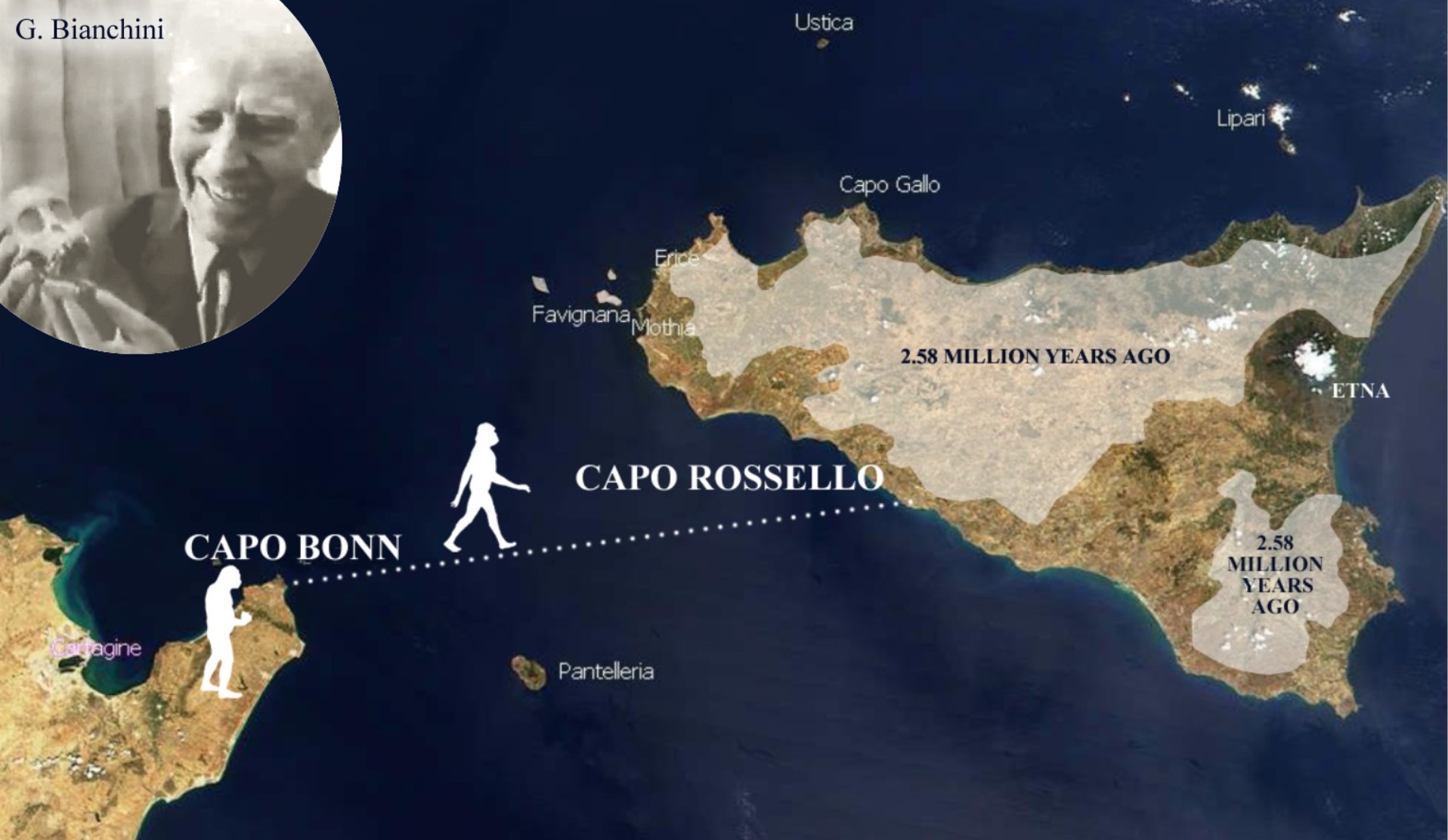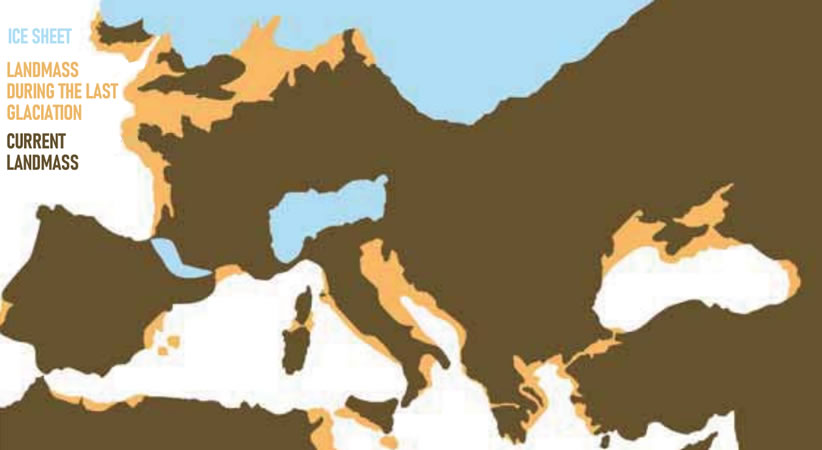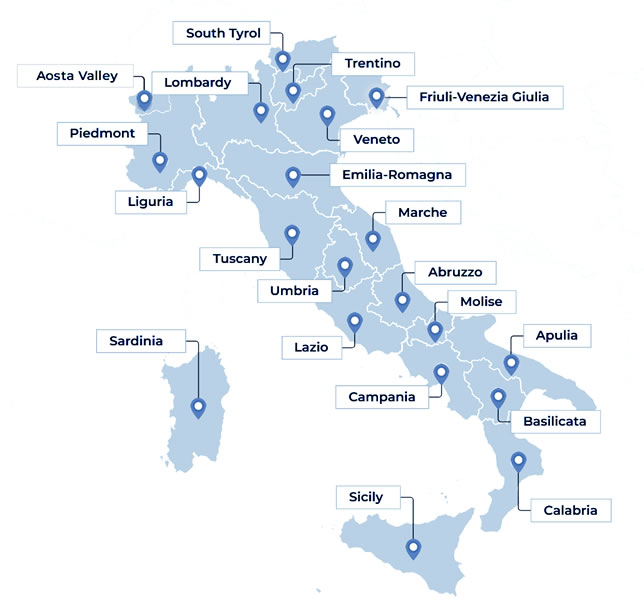

Explore Italy by place | region | time period
The Paleolithic Age » Realmonte (Agrigento, Sicily)
Hominid followed the mammals they hunted. According to scientists hominid began moving out of Africa across southern Eurasia around 2 million years ago. Around 1.6 million years ago they reached East Asia and Southeast Asia. After climate changes occurred (about 900,000 years ago), the hominid that settled in Eurasia began to migrate to southern Europe such as Italy, and while the climate changes continued, they migrated into northern regions of Europe in the space of 100,000 years.
Archaeological discoveries show that the first traces of human presence in the Italian peninsula date back to the Lower Paleolithic (from about 2.5 million to about 120,000 years ago): an example is Capo Rossello site in Sicily. Better known sites such as the Balzi Rossi caves (Ventimiglia, Liguria) belong to a more recent Paleolithic.

In prehistory Sicily may have had a great importance in the migration of the first men from Africa to Europe. In the 1960s, the anthropologist Gerlando Bianchini, founder of the Anthropology Museum in Agrigento, conducted various excavation campaigns in the coastal area of Realmonte. Here, on the Capo Rossello promontory, he found human remains (skull fragments and several teeth) which he assumed belonged to Australopithecus Siculus or gracilis, the earliest hominid ancestor of humankind.

Australopithecus was small in size compared to man. He was the progenitor of Homo sapiens (the only advanced hominid who spread around the entire globe), and lived between 5 and 3 million years ago. He was an anthropomorphic ape, that is to say of a shape similar to man, like chimpanzees and gorillas, but was different from monkeys, because he had a spine, limbs and rib cage. That allowed him to stand more and move around by limiting the use of the forelimbs, thus being able to use his hands for other functions such as carrying objects. Among all the australopithecines, the most famous is probably Lucy, that lived about 3.2 million years ago and was found in Ethiopia. In the subsequent evolution of Australopithecus various species were formed, almost all of which became extinct about 1 million years ago. Only one survives: homo sapiens sapiens (from Greek, the wisest man), which appeared about 130,000 years ago and to which all currently living humans belong.
(Note: hominid is the biological family that encompasses great apes: Australopithecus, as well as Homo Sapiens, are examples of biological species within that family).

However revolutionary, Bianchini's discovery was met with skepticism by the scientific community because it strongly changed the migration and settlement route used by humans during prehistory. It was in contrast with the common idea of ancient human dispersing (Africa -> Asia -> Europe -> Sicily).
Sicily occupies a central position in the Mediterranean basin: it is close to the Italian peninsula and to North Africa. With that discovery, the Sicilian island became a land of passage for an early human population coming from Africa to Europe (Africa -> Sicily -> Europe). On the other hand, there weren't enough further discoveries that could confirm this hypothesis since it was the migration of small groups of nomads who left very sporadic traces of their passage and their stay in a place. The only support for that theory was the result of investigations along the coast of the province of Agrigento, especially on the realmonte coast, which confirmed the existence of a Sicilian-Tunisian isthmus. It connected part of the Tunisian coast (Cape Bonn) to the Sicilian one and which therefore allowed Australopithecus to reach Europe. That occurred during some episodes of low-stand Mediterranean sea level when it dropped by about 120 meters. Those were possible sporadic bridges in the central Mediterranean, which connected the African continent to the European one over time for relatively short periods.

The size of the Mediterranean is modest compared to the extraordinary importance that this area has had from a historical and artistic point of view. It covers a small area of the global ocean surface (0.7%), about one thirty-second of the Atlantic and one seventy-second of the Pacific. Its inhabitants took a very long time to get to know it all: they had an approximate notion of it still in the Homeric age (11th-9th century BC). It began to form about sixty million years ago. Around 5.9 million years ago it was cut off from the Atlantic and was partly or completely desiccated over a period of some 600,000 years before being refilled by a flood. Today, the water temperatures are mild in winter and warm in summer. The Mediterranean sea encompasses a vast number of islands, some of them of volcanic origin. The two largest islands, in both area and population, are Sicily and Sardinia. If in the ancient times the Mediterranean sea was an important route for merchants and travellers - facilitating trade and cultural exchange between the peoples of the region - perhaps during the Paleolithic (from the Greek palaiós, ancient, and líthos, stone) it watched the passage for an early human population coming from Africa to Europe.

In order to know more, you can visit:
- Wikipedia: [1]
This page was last edited on 8 June 2024

Open in Google Maps and find out what to visit in a place.
Go to: Abruzzo | Aosta Valley | Apulia | Basilicata | Calabria | Campania | Emilia Romagna | Friuli Venezia Giulia | Lazio | Liguria | Lombardy | Marche | Molise | Piedmont | Sardinia | Sicily | South Tyrol | Trentino | Tuscany | Umbria | Veneto

Text and images are available under the Creative Commons Attribution-ShareAlike License 4.0; - italystudynotes.eu - Privacy